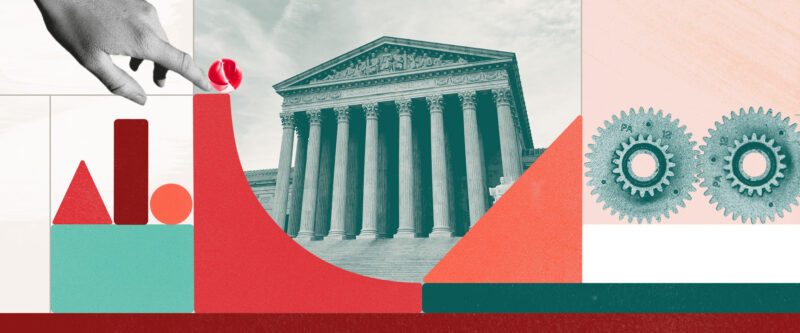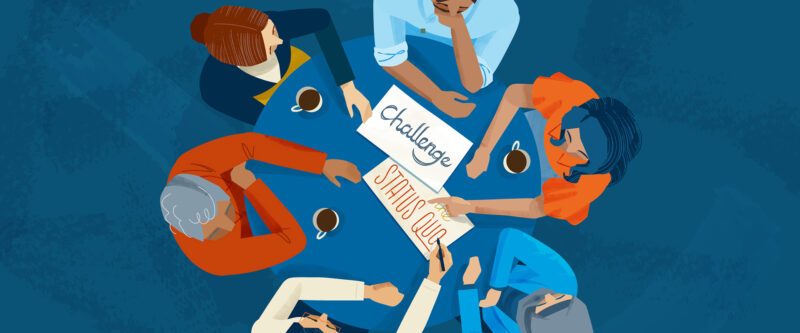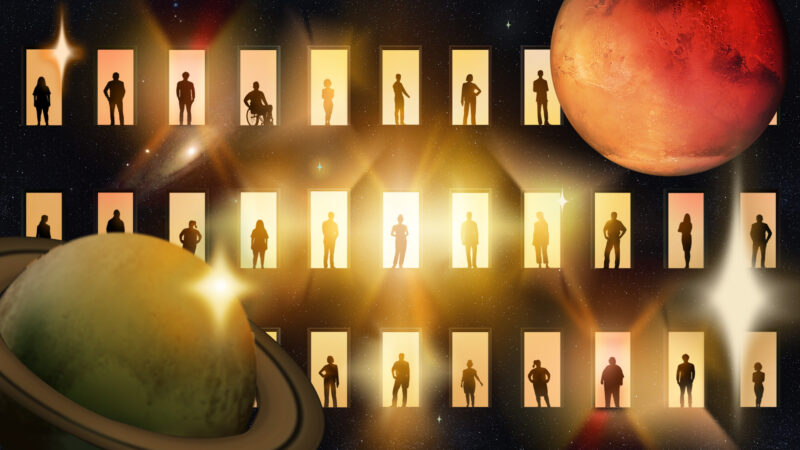Authors
Katie Trayte,
Brandy Kostick
Interviewee
Hannah Saidiner
An Interview with Director Hannah Saidiner
Our Creative Director, Katie, sat down with Hannah Saidiner to talk about her film My Parent, Neal which was recently featured in The New Yorker. They discuss the film, creating through the pandemic and making parents proud.
Hello, Hannah! Thanks for taking time to share about your film My Parent, Neal. It’s so exciting to finally see it published with The New Yorker. Could you tell our readers what you do at Duke & Duck?
Of course! It means so much to have the support of my coworkers during my film’s journey. I honestly still can’t even believe it’s officially out. I am a Designer (or Illustrator) meaning I create art direction, storyboards, and design for clients like National Geographic and the Legal Services Corporation. I started just after graduating from CalArts in 2021 as an apprentice before shifting to a full-time employee and have been here ever since!
My Parent, Neal was your CalArts student thesis film. Could you tell us about your experience at CalArts?
Yes! I technically started on the film in my junior year and then finished it completely in the summer just after graduating. I always sort of joke that I started at CalArts in high school and just kept going for college – I began taking animation classes through CalArts’ outreach programs when I was in tenth grade. For one summer program, I even lived on campus. When I got into the Experimental Animation program, it felt like the perfect continuation of my animation education.
I really value the education I received there, although 1.5 years of it ended up being online due to the pandemic. The major is unique in promoting real directorial skills and vision, even in the BFA program. I did struggle with that at times, perhaps craving more technical work on top of conceptual development, but it definitely encouraged me to develop confidence in my voice as a filmmaker. It ended up working out well as I’ve gained so much technical knowledge through professional experience, and feel like I have specific directing skills I value that really came from CalArts. This is especially true in the exposure I had to nonfiction and documentary animation. Between the Nonfiction Lab where filmmakers like Jennifer Levonian came to visit and the work by fellow alumnx like Melissa Ferrari, there was definitely an interest and emphasis in documentary animation that made me feel very comfortable in exploring that genre. My mentor, Pia Borg, was so instrumental in helping me craft the narratives of the three films I made during my time at CalArts. She consistently pushed me out of my comfort zone, encouraging me to not only work my hardest but always create work I was proud of and that felt worth making.
Walk us through the animation techniques you used to bring the film to life.
As I learned more during my time at CalArts, I realized that the processes I most enjoyed were probably considered pre-production: the interviews, the conceptualizing of visuals, and such. This made me lean more towards rotoscoping for the animation, so I could focus more time and energy in the parts I enjoyed most and use reference live-action footage. I also just loved how it looked – it felt like a perfect amount of separation from real life but just similar enough to feel like a slightly warped reflection of it.
While I was at home during the pandemic with my family, the three of us (my brother Avi, Neal, and I) spent one day over my winter break filming a bunch of footage I’d use for the film. I had done a full animatic blocking out the action with storyboards so we had an outline of what to capture. Whenever I was in the scene, my brother would be filming. When I wasn’t in a scene, I would capture the footage to get it as close to my original boards as possible. Once all that was accumulated, I worked with a classmate/animation assistant Eva Liebovitz to trace it all digitally in TVPaint. This was pretty simple in style, just black and white linework. The fun part came after: I printed out four of those linework frames to a page, flipped them over, and drew them again with colored pencil and watercolor. Another friend and mentor, Jamie Wolfe, recommended this technique and it ended up being perfect. I scanned those painted, colored frames and composited them together for the final piece online today! The process ended up being a great way to capture a tangibility and texture that I really wanted to evoke with the film, since much of what we speak about is physical changes that you can see, as well as the fluidity of evolving family relationships.
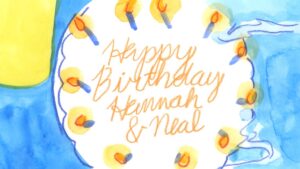
What was it like to shape a story from your interviews with Neal? Did you have a structure in mind going into your conversations, or did you find the story along the way?
By the time I created this film, I’d done three other short documentaries and felt more confident in my interviewing skills. I worked with my mentor to make a list of topics I would like to touch on in my initial conversation I’d have with Neal. That was a big part of it too, I wanted the final piece to feel like it had the back-and-forth I naturally have with my dad. To ensure that could happen, I didn’t even write out formal questions. I actually made one of those big mind maps that just had all these different branches I would bring up in the moment as they made sense. That recorded conversation ended up being about five hours. I took the next several months following to edit that down to the final seven-ish minutes of the film. I moved around the different parts of the interview that I chose to fit thematically and eventually create an effective arc for the story as it would be portrayed in the film.
That part of doing the interview and editing it down definitely felt the most natural for the story and the process as a whole. Because this film meant so much to me, I really did feel pressure to choose the “right” way to depict it visually. Something that simultaneously captured my relationship with my dad, how great his personality is, the complicated nature of our family, and his account of his transition. Eventually, I just grounded the visuals in what I really loved making and always felt like it made sense with my family stories: comics. My dad even originally wanted to be a cartoonist growing up and raised me on the Sunday funnies. I started making comics in high school/just beginning at CalArts, and really gravitated again towards the diary and auto-bio genres. Rotoscoping and my style of drawing comics felt really related in using linework and blocks of color to reflect and interpret real life. While the look of this film ended up being much looser, colorful, and textured, I started to really find my groove once I decided to create it with a similar approach to my comics visually. This applied to the moments captured too – I started with the interview audio (just like I would with an outline for a comic), and chose visual moments that felt related or representative.
Your conversation feels so honest and raw. Did the film allow you to have a really open exchange between parent and child– possibly for the first time?
One of the best parts of my relationship with my dad is that we have versions of this kind of conversation a lot. This one was very intentional, structured, and recorded. But, we have an amazing amount of honesty in our relationship and a willingness to really talk about anything. This was probably the first time we’d talked about all of this at once – sharing not only the joy of his transition but also the difficult emotions felt simultaneously and the way it impacted our family. It’s so wild to think about in some ways as we’ve come so far since that conversation recorded in 2019. We eventually did land on calling Neal, “Dad”. Even the title of the film is no longer accurate in that way!
What did animation bring to this documentary story that live-action footage couldn’t?
I think it again goes back to what comics and rotoscoping can do – they provide this reflection of reality, as dictated by the hand of an artist. You can create fluid seamless transitions or create moments that shift for just a few seconds into an imagined reality. The artist has complete control of the visuals, even when I used live-action footage to base it on. I also just have no formal live-action experience or understanding! I love reinterpreting stories in the animated format so even just from a personal standpoint, it’s a medium I really like.
My Parent, Neal has been screened at over 20 festivals. What advice would you give other student or independent filmmakers trying to break into the festival circuit?
The Experimental Animation program really promotes festival exposure so I think that education was helpful, and just starting to understand the amount of festivals out there. Look up filmmakers creating work similar to yours and see where their films have played and succeeded. Additionally, it’s extremely beneficial to create some sort of central document with festival names, submission deadlines, locations, and fees to apply. You can create a game plan of how much the submissions will cost (and alter it accordingly with your budget). Finding festivals that specifically match and highlight work with the themes of your film is beneficial too. I applied to almost every festival through Film Freeway so I’d definitely recommend starting out by just making an account and browsing the huge variety of festivals out there.
This film has garnered so many accolades. From winning the Creative Future Innovation Award at Slamdance, to becoming Oscar-qualifying, and now featured on The New Yorker’s website. How has Neal felt about the film’s success?
Neal has always been my biggest cheerleader, and this film is no exception. Each moment there’s been an accolade given for the film, it’s been a great reason to reflect back on our relationship and the love and appreciation we can show one another.
It’s been great to shed some of that appreciation he always gave me growing up back on him and remind him that so much of the praise and recognition is due to how amazing he is as a person and parent. I think he still doesn’t fully comprehend that, as his daily life is essentially the same. I make sure to call him and remind him.
Could you tell us a little bit about how the film came to be distributed through The New Yorker?
I was emailed by a member of the Condé Nast team who noticed my film in the lineup of the Thomas Edison Film Festival and thought it might work well with their programming. I couldn’t believe it at first but sent over the link and waited anxiously to hear back! A few months later, I was contacted and told how much they were touched by my film, and we began the conversation about partnering with The New Yorker for distribution. Their producers and acquisition team were great collaborators through the process and I’m so proud to have my film on their site today.
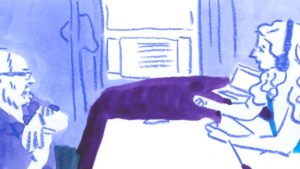
Over My Parent, Neal’s journey, what have you been most proud of?
Having other people witness Neal, his journey, and his joy has been incredible. He’s always been the “cool dad” to my friends but I feel so lucky to be able to share him with the world through this film. Sitting in a theater in his hometown of San Francisco in April 2022, watching him watch the film, and for both of us to hear the audience laughing and buzzing to the story, was such an amazing experience. It felt like a real full circle moment for him to return to the city he’d moved from with his family at 16 and return so many years later feeling like the most realized version of himself. I could bring him to this festival, celebrating his impact on my life, and he could take me around the city to everywhere meaningful to him, giving a greater understanding to both where he came from and who he is now.
Where can we find more of your work?
You can find more of my work on my website and my other short films on my Vimeo! My Parent, Neal is streaming online now on The New Yorker’s website along with an interview I did with them, and there’s behind the scenes images and video up on my website for it as well.



